Synesthesia
通感的例句
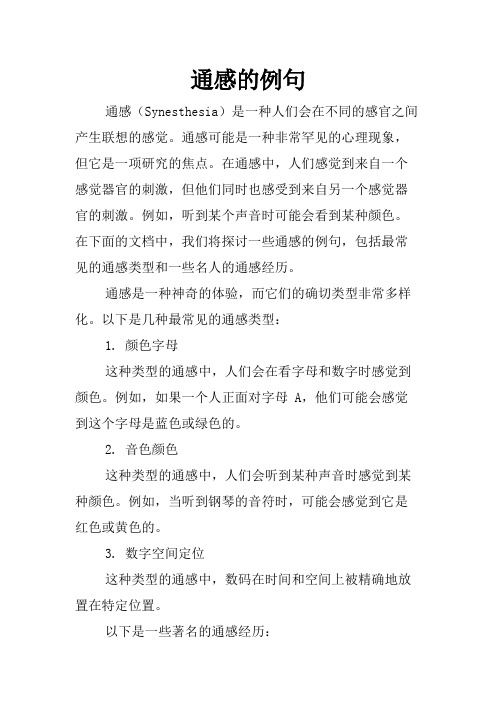
通感的例句通感(Synesthesia)是一种人们会在不同的感官之间产生联想的感觉。
通感可能是一种非常罕见的心理现象,但它是一项研究的焦点。
在通感中,人们感觉到来自一个感觉器官的刺激,但他们同时也感受到来自另一个感觉器官的刺激。
例如,听到某个声音时可能会看到某种颜色。
在下面的文档中,我们将探讨一些通感的例句,包括最常见的通感类型和一些名人的通感经历。
通感是一种神奇的体验,而它们的确切类型非常多样化。
以下是几种最常见的通感类型:1. 颜色字母这种类型的通感中,人们会在看字母和数字时感觉到颜色。
例如,如果一个人正面对字母 A,他们可能会感觉到这个字母是蓝色或绿色的。
2. 音色颜色这种类型的通感中,人们会听到某种声音时感觉到某种颜色。
例如,当听到钢琴的音符时,可能会感觉到它是红色或黄色的。
3. 数字空间定位这种类型的通感中,数码在时间和空间上被精确地放置在特定位置。
以下是一些著名的通感经历:莉亚·珀茨曼(Lorde)该流行音乐歌手Lorde是那些拥有音色颜色通感的人之一。
在她的歌曲中,她经常会谈到音乐的“棕色”和“粉色”色调。
她在接受采访时,表示自己对这种体验非常感兴趣,并且她把这种体验应用到她的音乐中。
大卫·修曼(David Hockney)大卫·修曼是一名著名的画家和艺术家,以其对色彩的灵活运用而知名。
然而,人们可能不知道他是一个拥有颜色声音通感的人。
在他的绘画过程中,他常常将不同的音乐类型与颜色相联系。
例如,当听到蓝调音乐时,他会使用深色调和低饱和度的颜色。
温斯顿·丘奇(Winston Churchill)温斯顿·丘奇是20世纪英国的一位杰出政治人物。
然而,他也是那些拥有颜色字母通感的人之一。
他以前曾描述说,在他的想象中,字母“S”出现的更像是深绿色。
玛丽莲·梦露(Marilyn Monroe)虽然玛丽莲·梦露的通感无论是哪种类型都没有得到官方的确诊,但一些报告表明,她可能是曾经拥有色彩数字通感的人之一。
抽象概念的提炼到具象手法的落地——浅谈建筑设计中的联觉转化

R E A LE S T A T EG U I D E |71抽象概念的提炼到具象手法的落地浅谈建筑设计中的联觉转化李 娜 (香港华艺设计顾问(深圳)有限公司 广东 深圳 518000)[摘 要] 建筑设计讲解中,设计主创首先会被问到的问题:项目设计概念/理念是什么?概念/理念的提出是建筑设计初期非常重要的一个环节,她是建筑的灵魂,也是设计者对项目特点的浓缩提炼,是把抽象的设计想法转化为具象实体建筑空间的方式㊂优秀的概念提炼可贯穿建筑设计始终㊂本文结合具体项目案例解释设计概念的抽取过程,以及此概念落地后在心理层面对观者的影响,并用 联觉 这种心理学现象,分析设计概念缘何引起观者共鸣㊂[关键词] 联觉;艺术设计;抽象设计;具象设计;转化;设计概念/设计理念[中图分类号]T U-0 [文献标识码]A [文章编号]1009-4563(2023)24-071-031 引言艺术设计中有一重要的概念称之为 联觉(S yn e s t h e s i -a) ,是指一种感觉引起其他感觉的心理现象,联觉一词源自古希腊㊂人类大脑中的认知和记忆区域会参与到联觉的形成中,这些区域会将过去的经验㊁知识和记忆与联觉相结合,从而影响人们的心理和情感状态㊂让.保罗.萨特在‘B e i n g a n dN o t i n gn e s s (存在与虚无)“中谈到感官的主观性与世界的客观性是一种整体的互相渗透的状态㊂他的这种描述常被引用在关于 联觉 的论述中㊂艺术设计本身,无论是建筑㊁雕塑㊁绘画还是音乐㊁舞蹈等形式,都可以说是一种联觉体验,在这些体验的过程中,人们在感官之间穿行着,将看似无关的概念联结起来,并由此带来创造性启发㊂再回到建筑设计过程中的设计概念的引入,即可理解为一个将抽象的设计概念与具体的建筑形象之间产生连接㊁并创造性转化的过程㊂这种联觉手法的使用,将内心中的感知转化为另一种层面的认知,从而使观看者对设计概念发生认同㊁产生共鸣㊂用我们传统的文化来解释,即是一种 触景生情 的体验㊂将抽象的感受注入建筑立面设计或是将建筑立面赋予与心理层面相匹配的感受,特别是在公共建筑的设计中,是一种重要的转化能力㊂转化/链接手法的高低,与落地后的准确度,也是评判一个建筑师能力的重要指项㊂建筑设计过程通常分为:概念提练㊁概念结合㊁概念落地几个步骤㊂笔者将结合近几年的几个参与㊁或合作过的项目案例为基础,来初步讨论建筑设计中抽象概念层面直到设计落地具象逻辑思维层面过程中的感知转化㊂2 结合案例的研究2.1 深报业印刷大楼:形象与精神的融合2.1.1 项目信息报业集团书刊大厦项目位于深圳龙华街道,于2010年设计,用地定位为高度不超50m 的印刷印务大楼,包括裙房部分与主塔楼部分功能,用地较为狭长,功能定位为报业集团印刷基地㊂2.1.2 概念抽取深圳报业集团于2002年9月30日组建,为中国十大报业集团之一,是我国规模最大㊁现代化程度最高的党报传媒集团之一㊂也是特区精神的象征者与引领者㊂设计阶段,反复思考如何在常规地块及高度的场地,赋予建筑特有的造型意向,并同时能够体现报业集团敢闯敢试㊁敢为人先㊁艰苦奋斗的企业精神?深圳报业集团于1997年落成的首栋标志性大厦其 新闻巨舰 的定位研究,结合项目用地条件及建筑基本形态,笔者提出结合 报业新舰船 的定位㊂为了突显项目的建筑张力与活力,设计采用了整体体量略微倾斜的手法形式,寓意扬帆起航的船㊂希望建筑在有限的高度㊁有限的体量大小基础上能从周边环境中脱颖而出㊂塔楼前部的办公盒子展现活泼生动的色彩,形成一个视觉焦点㊂舒展的塔楼表皮与裙房共同围合成窗口的造型,寓意报业集团二期印务中心承载着深圳文化之窗的重任飞速发展㊂后续立面的线性设计手法沿用整体设计概念,强调整体建筑的动态感,也代表层叠的报纸㊂也呼应了报业集团在特区建设早期对区域的带动力及影响力㊂就此定位完成项目概念与手法的统一性整理㊂图2.1 图片来源:作者自摄最终建筑落成效果,与初期设计非常一致㊂此项目获得2019年度国家勘察设计优秀(公共)建筑设计奖三等奖㊂2.1.3 总结本项目建筑形象的隐喻通属于结合场地及高度条件,从公司的品牌形象抽取出本地建筑可能具有的设计场景/精神㊂并结合具体设计手法(略微倾斜的建筑形体㊁立面横向线条)完成概念到具象形象(舰船㊁层叠的报纸)的呼应㊂人们会感受到建筑的动态感及连续性,同时也会被独特的形体与立面设计元素和细节所吸引,激发对建筑和设计的关注与好奇㊂72 |R E A LE S T A T EG U I D E本项目手法概念引述上较为直白,也非常易懂㊂通过建筑整体能体会到他所传达出的信息及内涵㊂完成了项目与人与周边建筑的对话㊂2.2 均安文化站:重塑传统建筑意向2.2.1 项目信息均安文化站设计时间为2017年㊂项目位于广东省佛山市均安镇百安路㊂文化活动站位于地块西北街角㊂前期售楼阶段作为售楼处使用,后期使用阶段作为文化活动站功能㊂在本项目中,设计者面临的问题是位置虽在街角,但建在塔楼下的只有1层的体量,存在感较弱,如何满足前期销售处要求,且室内柱网已经固定不能改变㊂如何结合有限条件满足前期销售处形象感的设计要求,是需要解决的矛盾㊂2.2.2 概念抽取笔者接手方案设计时,前述设计团队已完成几轮方案设计,皆没有被采纳㊂认为方案单纯抛出形体意向,缺少内涵与设计分析支持㊂后续结合业主方调研报告,调整设计策略㊂新方案将结合均安地域文化,提炼示范区的概念,增强示范区的看点与故事性㊂为项目注入精神性与文化性㊂后深入了解,均安镇是一个有深厚历史底蕴的文化名镇,素有中国 曲艺之乡 的美誉,每个村居都有曲艺社,有着 万家灯火万家弦 的文化特征㊂于是我们引入 戏曲 的概念㊂运用当代的设计手法雕刻一座有传统韵味的戏园,于游廊回折和水榭台筑中体验传统戏曲文化的迷人魅力,仿若时光倒流,寻觅均安人骨子里的精神归属㊂最终会所单体的设计吸收与借鉴了传统戏曲和戏台的诸多元素㊂从 戏台 游廊 的故事线,抽象出展示区建筑造型:(1) 游廊 意向与参观游览流线设计的融合:访客从场地西部进入,穿越一条曲折回廊;穿行于青葱绿村和假山片石间,如若置身于传统园林之中㊂ 初极狭,才通人,复行数十步,豁然开朗㊂(2) 看与被看 的设计理念:行至廊端头,一面绿水映入眼帘:目之所及,便是我们会所所在㊂漂浮于水面上的会所,份佛园林中的水榭,倒影摇曳在粼粼波光中㊂(3)造型形象的抽象提取:建筑中部放空,两端形体中轴对称,将视觉的焦点集中在建筑的中部,充分利用通感的手法让观者感受到戏台空间的氛围㊂(4)建筑的双层飘顶,用简洁有力的当代形式呼应传统戏台建筑的双层屋檐,灵动飘逸无限延伸㊂图2.2 图片来源:作者团队绘制此案例重要点在于使用了我国传统建筑元素--重檐㊁挑檐的设计手法㊂建筑形体通过深远的大屋面,以及现代的材料和工艺做法,试图创造出轻盈而富有变化㊁呈现出现代中式语境的立面效果㊂虽然使用不同材料(传统建筑用木,现代建筑用金属),但手法的相似使用可轻易唤起中国人对于传统建筑的记忆㊂从而引发情感归宿感与精神共鸣,此便是从脑到心的全过程感知链㊂不用传统语言便能读懂㊂除此之外,景观与室内设计单位也为此种中式效果的呈现做了主题呼应㊂景观的游廊从室内到室外㊁充满即舒适㊁又能符合现代人审美的特色中式空间,达到整体体验空间的延续与统一㊂此项目获得2020深圳勘察设计工程二等奖㊂2.3 昆明巫家坝:抽象美学的实现2.3.1 项目信息项目位于昆明巫家坝片区核心地段,为原昆明机场旧址区域,也位于南方丝绸之路经济带上㊂地块内包含住宅㊁公寓㊁办公三种业态㊂其中办公塔楼面对巫家坝片区主要大道春城大道与经三路的交汇路口㊂塔楼限低210m ,需要有标志性的形象与地段相匹配㊂2.3.2 概念抽取最初办公立面设计团队提出四种塔楼概念:(1)云南之门㊂塔楼吸取老街木构格栅门窗手法做法,用竖向窗框式构件回应中国传统,展现门户地位,又赋予塔楼庄重挺拔的建筑形象㊂(2)孔雀蓝㊂孔雀为云南的文化名片之一㊂立面设计以开屏孔雀为概念,通过表皮的轻微折叠,形成标准层塔楼至顶部的渐变形象,表达孔雀开屏之势,与云南国宝,巫家坝历史交相辉映㊂(3)彩云之南㊂方案塔楼以圆柔的圆角处理,以云彩层层相叠的意向为灵感创造幕墙前后错落相叠而上的丰富质感,使塔楼与 云之南 的美丽㊁富饶㊁神奇意向相呼应㊂(4)石峰㊂作为世界典型的喀斯特地貌区,昆明石林是中国的四大景观之一㊂石林这一昆明文化与标志感为本项目带来灵感㊂鬼斧神工的竖向沟壑演变为塔楼两角的退台,千嶂叠翠的美景对应现代的绿色露台处理手法㊂最终,通过多轮决策,塔楼立面选用当地大众熟知的孔雀 形象㊂孔雀开屏时羽毛折叠美感与表皮的轻微折叠处理的韵律感相转化,属于形态上的联觉初看设计大众也可以对设计概念无所知的情况下,也可以对 美 的形象能做到初步感知㊁认可㊂未来大楼宣传若能配合设计师的概念初衷,用 孔雀 这个正面优美形象与大众形成情感共鸣,便能形成非常积极形象的一文化名片㊂2.3.3 总结最终,本项目立面合作设计团队完美完成塔楼设计任务㊂通过对昆明区域文化特色提取,完成从设计概念到具体形象的美学及技术层面的转化,后期建筑完美落地呈现㊂给人以优美㊁灵动的城市印象,达到了概念与落地效果的完美契合㊂(下转第75页)R E A LE S T A T EG U I D E |75基于市政给排水管道设计风险评价机制,需对最大特征根λm a x 及一致性比率C.R 进行风险验证,计算公式如下:C ㊃R=C ㊃IC ㊃R式中,C ㊃I 表示一致性指标,C ㊃R 表示一致性比率,R㊃I 表示随机一致性指标㊂R ㊃I 的取值如表3所示㊂表3 随机一致性指标数据n123456789R.I0.000.000.580.901.121.251.3211.411.452.4 综合优化在市政工程中,给排水管道的建设往往与现有的供暖管线㊁电缆和天然气管道存在交叉和重叠㊂这就要求设计者必须进行精确的计算,确保新铺设的管道避开已有的市政设施,防止交叉冲突㊂B I M 技术在这一过程中扮演了至关重要的角色㊂通过B I M 技术,设计师可以创建施工区域的给排水管线三维模型,并将其与现有市政管线的模型进行融合,从而有效地规避潜在的建设问题㊂B I M 技术中的碰撞检测功能是此过程中的一个关键工具㊂它可以自动检测出给排水管线与其他设施之间的任何潜在冲突,并生成详细的碰撞报告㊂设计团队可以根据这些报告对设计进行必要的调整,从而在施工阶段之前优化设计方案㊂例如,在某地区进行雨污分流改造工程时,运用B I M 进行三维建模和设计分析不仅保障了工程的顺利进行,还确保了设计的准确性和施工的安全性,最终促进了工程设计的整体优化和提升㊂图4为市政雨污分离改造㊂图4 市政雨污分离改造通过将R e v i t 软件与B I M 技术结合,设计师能够对市政给排水管线进行精确的布局优化模拟,从而显著降低管道间的潜在冲突和碰撞风险㊂市政给排水系统设计是一个系统化的过程,它需要与城市中的其他基础设施工程紧密协调和组织㊂B I M 技术的应用能够在设计阶段就对管线铺设方案进行调整和优化,确保给排水系统设计与工程建设的无缝对接,并高效地整合到整个城市基础设施网络中㊂结论本文深入探讨了B I M 技术在市政给排水工程设计中的多方位应用,从设计图纸的可视化改善到设计流程的优化,再到管线建材的甄选以及整个施工过程的综合优化㊂通过实例分析,我们发现B I M 技术能够有效降低设计和施工过程中的错误率,减少因重新设计和施工带来的成本㊂B I M 技术提供的三维模拟和碰撞检测功能,让设计人员能够更精确地进行管线铺设,优化资源配置,并提高施工效率㊂最终,这种技术的应用大大提升了市政给排水系统的建设质量,为未来智慧城市的基础设施建设奠定了坚实的技术基础㊂参考文献[1] 司马岩.提高市政给排水设计合理性的有效措施研讨[J ].工程建设与设计,2023(18):83-85.[2] 胡敏.基于B I M 技术的市政给排水设计及应用研究[J ].工程技术研究,2023,8(15):213-215.[3] 宋涛,贺亚.B I M 技术在市政给排水设计中的应用[J ].中华建设,2023(05):137-139.(上接第72页)图2.3 图片来源:作者公司版权3 总结建筑设计中所谓的概念,真正代表的内涵是什么?建筑师将复杂的设计目标和想法归纳为简洁㊁凝练的表达㊂设计师通过深入研究项目的背景㊁环境㊁功能需求和用户体验,提取出关键的元素㊁主题或意象并将其转化为概念表达㊂而概念的提炼,最终的目的,希望通过非语言的力量,如形态㊁立面手法㊁材质㊁光影等,创造出独特的氛围㊁情感和体验,呈现出的作品能与观者体验相关联,与人产生共鸣,留下深刻印象,做到最终打动人心的建筑形体或空间体验㊂参考文献[1] ‘B e i n g a n dN o t i n g n e s s (存在与虚无)“让.保罗.萨特[2] ‘艺术与视知觉“鲁道夫㊃阿恩海姆R u d o l fA r n h e i m[3] ‘星期三是靛蓝色的蓝“[美]理查德㊃西托维奇[美]戴维㊃伊戈曼[4] ‘设计心理学“唐纳德㊃A ㊃诺曼。
《高级英语》复习资料 The Review of Advanced English2
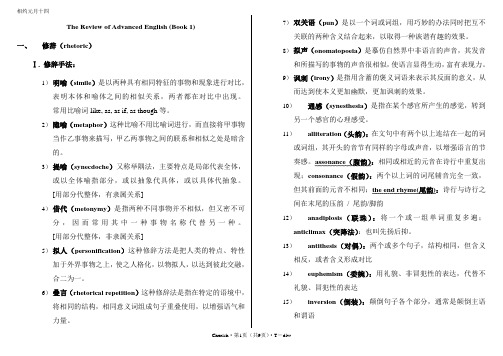
The Review of Advanced English (Book 1)一、修辞(rhetoric)Ⅰ. 修辞手法:1)明喻(simile)是以两种具有相同特征的事物和现象进行对比,表明本体和喻体之间的相似关系,两者都在对比中出现。
常用比喻词like, as, as if, as though等。
2)隐喻(metaphor)这种比喻不用比喻词进行,而直接将甲事物当作乙事物来描写,甲乙两事物之间的联系和相似之处是暗含的。
3)提喻(synecdoche)又称举隅法,主要特点是局部代表全体,或以全体喻指部分,或以抽象代具体,或以具体代抽象。
[用部分代整体,有隶属关系]4)借代(metonymy)是指两种不同事物并不相似,但又密不可分,因而常用其中一种事物名称代替另一种。
[用部分代整体,非隶属关系]5)拟人(personification)这种修辞方法是把人类的特点、特性加于外界事物之上,使之人格化,以物拟人,以达到彼此交融,合二为一。
6)叠言(rhetorical repetition)这种修辞法是指在特定的语境中,将相同的结构,相同意义词组成句子重叠使用,以增强语气和力量。
7)双关语(pun)是以一个词或词组,用巧妙的办法同时把互不关联的两种含义结合起来,以取得一种诙谐有趣的效果。
8)拟声(onomatopoeia)是摹仿自然界中非语言的声音,其发音和所描写的事物的声音很相似,使语言显得生动,富有表现力。
9)讽刺(irony)是指用含蓄的褒义词语来表示其反面的意义,从而达到使本义更加幽默,更加讽刺的效果。
10)通感(synesthesia)是指在某个感官所产生的感觉,转到另一个感官的心理感受。
11)alliteration(头韵):在文句中有两个以上连结在一起的词或词组,其开头的音节有同样的字母或声音,以增强语言的节奏感。
assonance(腹韵):相同或相近的元音在诗行中重复出现;consonance(假韵):两个以上词的词尾辅音完全一致,但其前面的元音不相同;the end rhyme(尾韵):诗行与诗行之间在末尾的压韵/ 尾韵/脚韵12)anadiplosis(联珠):将一个或一组单词重复多遍;anticlimax(突降法):也叫先扬后抑。
英语中的修辞 英文版
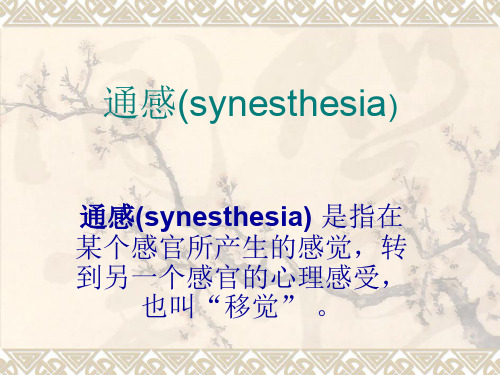
paid for their predilection for starchy and sugary foods has been the premature decay and loss of teeth.
移就(Transferred epithet )
所谓“移就”(也叫“移用”),就是把描写甲 事物的词语有意识地移用来描写乙事物;
Transferred epithet is a figure of speech that an epithet (an adjective or descriptive phrase) is transferred from the noun it should rightly modify to which it does not really belong.
2. The man can't be trusted. He is as slippery as an eel. 那个 人不可信赖。他像鳗鱼一样狡猾。
3. He jumped as if he had been stung.他像被蜇了似的跳了起 来。
4. Childhood is like a swiftly passing dream. 童年就像一场疾 逝的梦。
通感(synesthesia)
通感(synesthesia) 是指在 某个感官所产生的感觉,转 到另一个感官的心理感受,
也叫“移觉” 。
文学领域中的通感,钱钟书先生曾下过一个 定义:“在日常经验里,视觉、听觉、触觉、 嗅觉、味觉往往可以彼此打动或交通,眼、 耳、舌、鼻、身各个官能的领域可以不分界 限。颜色似乎会有温度,声音似乎会有形象, 冷暖似乎会有重量,气味似乎会有锋芒。” 简单的说,感官感觉虽然功能和活动范围不 同,但同时又会相互影响。比如听到声音感 觉看到颜色,看到颜色又感觉在触摸什么。
英语修辞之通感
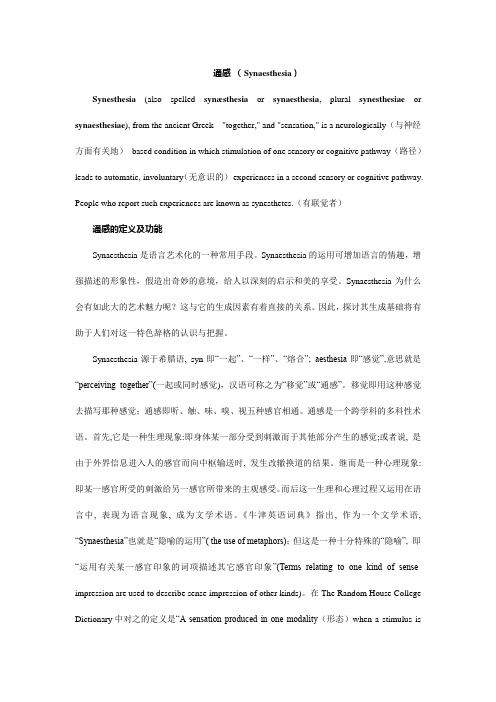
通感(Synaesthesia)Synesthesia(also spelled synæsthesia or synaesthesia, plural synesthesiae or synaesthesiae), from the ancient Greek "together," and "sensation," is a neurologically(与神经方面有关地)based condition in which stimulation of one sensory or cognitive pathway(路径)leads to automatic, involuntary(无意识的)experiences in a second sensory or cognitive pathway. People who report such experiences are known as synesthetes.(有联觉者)通感的定义及功能Synaesthesia是语言艺术化的一种常用手段。
Synaesthesia的运用可增加语言的情趣,增强描述的形象性,假造出奇妙的意境,给人以深刻的启示和美的享受。
Synaesthesia为什么会有如此大的艺术魅力呢?这与它的生成因素有着直接的关系。
因此,探讨其生成基础将有助于人们对这一特色辞格的认识与把握。
Synaesthesia源于希腊语, syn即“一起”、“一样”、“熔合”; aesthesia即“感觉”,意思就是“perceiving together”(一起或同时感觉),汉语可称之为“移觉”或“通感”。
移觉即用这种感觉去描写那种感觉;通感即听、触、味、嗅、视五种感官相通。
通感是一个跨学科的多科性术语。
首先,它是一种生理现象:即身体某一部分受到刺激而于其他部分产生的感觉;或者说, 是由于外界信息进入人的感官而向中枢输送时, 发生改辙换道的结果。
NLP名词解释
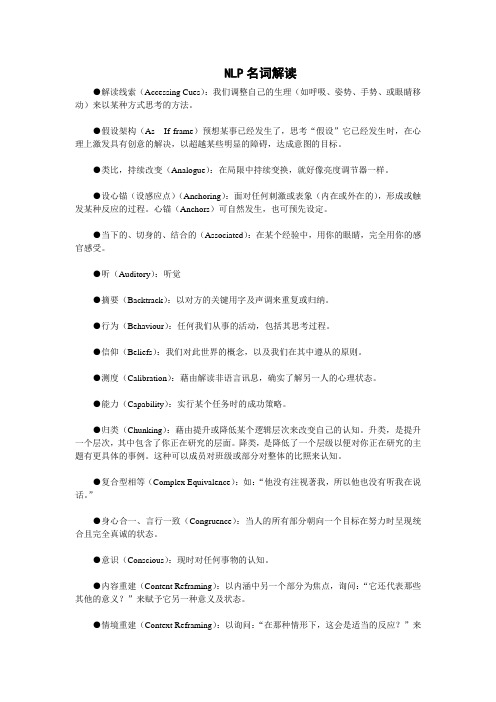
NLP名词解读●解读线索(Accessing Cues):我们调整自己的生理(如呼吸、姿势、手势、或眼睛移动)来以某种方式思考的方法。
●假设架构(As - If frame)预想某事已经发生了,思考“假设”它已经发生时,在心理上激发具有创意的解决,以超越某些明显的障碍,达成意图的目标。
●类比,持续改变(Analogue):在局限中持续变换,就好像亮度调节器一样。
●设心锚(设感应点)(Anchoring):面对任何刺激或表象(内在或外在的),形成或触发某种反应的过程。
心锚(Anchors)可自然发生,也可预先设定。
●当下的、切身的、结合的(Associated):在某个经验中,用你的眼睛,完全用你的感官感受。
●听(Auditory):听觉●摘要(Backtrack):以对方的关键用字及声调来重复或归纳。
●行为(Behaviour):任何我们从事的活动,包括其思考过程。
●信仰(Beliefs):我们对此世界的概念,以及我们在其中遵从的原则。
●测度(Calibration):藉由解读非语言讯息,确实了解另一人的心理状态。
●能力(Capability):实行某个任务时的成功策略。
●归类(Chunking):藉由提升或降低某个逻辑层次来改变自己的认知。
升类,是提升一个层次,其中包含了你正在研究的层面。
降类,是降低了一个层级以便对你正在研究的主题有更具体的事例。
这种可以成员对班级或部分对整体的比照来认知。
●复合型相等(Complex Equivalence):如:“他没有注视著我,所以他也没有听我在说话。
”●身心合一、言行一致(Congruence):当人的所有部分朝向一个目标在努力时呈现统合且完全真诚的状态。
●意识(Conscious):现时对任何事物的认知。
●内容重建(Content Reframing):以内涵中另一个部分为焦点,询问:“它还代表那些其他的意义?”来赋予它另一种意义及状态。
●情境重建(Context Reframing):以询问:“在那种情形下,这会是适当的反应?”来改变某个状态的情境,赋予它另一种意义。
英语修辞.Synaesthesia 移觉,同感 parody仿拟,诙谐

2). Transference of sense
hearing
of
• (1) Heard melodies are sweet, but those unheard are sweeter. • (By John Keats) • ---In “melodies are sweet” is the mixture of the sense of hearing and the sense of taste;
3). Transference of sense of
taste
• • • • • • • (2) And all men kill the thing they love, By all let this be heard, Some do it with a bitter look, Some with a flattering word, The coward does it with a kiss, The brave man with sword! (By Oscar Wilde)
18. Parody诙谐 、仿拟
• Parody was originally desired to ridicule. Now it can be used to produce any desired effect by its • varied forms and its striking contrasts.
4). Transference of sense
smell
of
• (2) But, in embalmed darkness, guess each sweet wherewith the seasonal month endows the grass. • (By John Keats) • ---the mixture of sense of smell and the sense of sight
英语中常见的修辞手法

英语中常见的修辞手法Prepared on 22 November 2020英语中常见的修辞手法英语中常见的修辞手法1明喻(Simile) simile-简明英汉词典['smli:]n.(使用like或as等词语的)明喻明喻是一种最简单、最常见的修辞方法,是以两种具有共同特征的事物或现象进行对比,表明本体和喻体的关系,两者都在对比中出现,其基本格式是“A像B”,常用的比喻词有as, like, as if, as though等。
如果使用得当可以把深奥的道理说得通俗、浅显、明白,使人可见可感可悟,把简单的事物表达的更为形象更为生动。
例如:(正如爬山,我们费力爬上三英尺,Like climbing a mountain, we struggle up three feet and fall back two.又掉下去两英尺。
)(大学英语第一册第三单元课文B)I see also the dull, drilled, docile, brutish masses of the Hun soldiery blodding on like a swarm of crawling locusts.(丘吉尔在此使用了一个恰当的比喻,把德国士兵比作蝗虫,因为二者有着共同之处-传播毁灭。
)2暗喻(the metaphor)metaphor-简明英汉词典['metf]n.隐喻暗喻也是一种比喻,但不用比喻词,因此被称作缩减了的明喻(a compressed simile)。
它是根据两个事物间的某些共同的特征,用一事物去暗示另一事物的比喻方式。
本体和喻体之间不用比喻词,只是在暗中打比方,从而更生动、更深刻地说明事理,增强语言的表现力。
例如:(我将全力帮助他穿越人生的惊涛骇浪。
)I will do anything I can to help him through life's dangerous sea.(第二册第三单元课文A)Consider that the same cultural soil producing the English language also nourished the great principles of想想吧,孕育英语的文化土壤也同样为当今世界培育了自freedom and right of man in the modern world.(由和人权准则。
synaesthesia
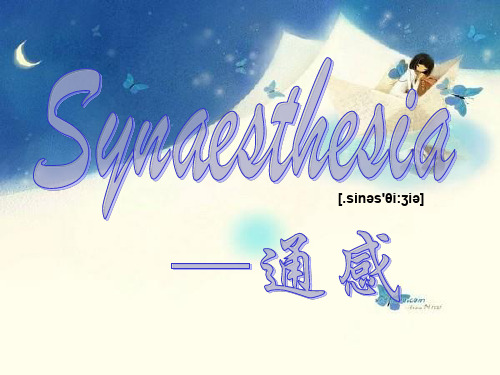
Synaesthesia [American: synesthesia] comes from the Greek 'syn' (together) + 'aesthesis' (perception), and denotes the blending of different sensory sensations. For example, people with 'coloured hearing' experience colours when they listen to music or the sound of speech. Other examples of synaesthesia include experiencing taste from written words, or the sensation of tactile shapes from smells. The most common form is colours trigged by letters, numbers and words. Synaesthesia is not the same as simple metaphor, which all people do (e.g., saying that anger is red) and is more than simply the artistic sensitivity to colours. “蓝色星期一”、 “她的声音好甜”、“冷/暖颜色”等,对於这类特殊的比喻,我们时 蓝色星期一” 她的声音好甜” 暖颜色” 对於这类特殊的比喻, 蓝色星期一 暖颜色 有所闻,虽并非真到声音的甜味,颜色的冷热,看到日期的颜色, 有所闻,虽并非真到声音的甜味,颜色的冷热,看到日期的颜色,但能领会其所表达的 意境。然而对有一小部分人,这不是修辞上的比喻而已; 意境。然而对有一小部分人,这不是修辞上的比喻而已;而是确实有上述跨感官的经验 感觉:当看到“ 星期一”这三个字时,会看到蓝色光晕附着在字面上;听到声音, 感觉:当看到“ 星期一”这三个字时,会看到蓝色光晕附着在字面上;听到声音,嘴里 就有伴随声音而生味觉。这种不寻常的感知现象,心理学名为“ 就有伴随声音而生味觉。这种不寻常的感知现象,心理学名为“ Synaesthesia”。这个 。 字源於希腊文"syn"(综合 综合)+aisthesis(感官知觉 ,意谓各感官之间的相互综合。联觉的种 感官知觉), 字源於希腊文 综合 感官知觉 意谓各感官之间的相互综合。 类很多, 类很多,广泛而言涵盖了五大感官 (视、听、嗅、味、触)中,原本毫无关联之刺激项与 视 中 感觉项的相连; 音乐→色彩视觉 疼痛→颜色感觉 感觉项的相连;例如听觉引发视觉 (音乐 色彩视觉 ,触觉引发视觉 (疼痛 颜色感觉 音乐 色彩视觉) 疼痛 颜色感觉) 事实上,除了上述的五大感官,语言文字本身也能触发联觉,像上述的星期与颜色、 等。事实上,除了上述的五大感官,语言文字本身也能触发联觉,像上述的星期与颜色、 听到语言引发味觉等。 听刺激→听觉 听到语言引发味觉等。一般固有的观念是各感官之间有明确的划分 (听刺激 听觉;视刺 听刺激 听觉; 视觉; 触觉), 激→视觉;触刺激 触觉 ,彼此间平行运作。但联觉现象的发现打破了这个固有观念; 视觉 触刺激→触觉 彼此间平行运作。但联觉现象的发现打破了这个固有观念; 感官之间不仅能相互触发,语言概念本身也可以引发感觉经验。换言之, 感官之间不仅能相互触发,语言概念本身也可以引发感觉经验。换言之,联觉不仅是跨 感官,也可以横跨意识概念与感觉经验。 感官,也可以横跨意识概念与感觉经验。
英语文学中得修辞手法
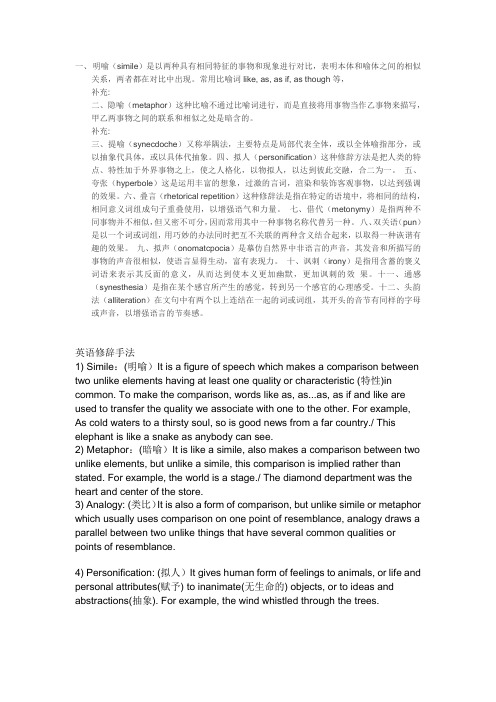
一、明喻(simile)是以两种具有相同特征的事物和现象进行对比,表明本体和喻体之间的相似关系,两者都在对比中出现。
常用比喻词like, as, as if, as though等,补充:二、隐喻(metaphor)这种比喻不通过比喻词进行,而是直接将用事物当作乙事物来描写,甲乙两事物之间的联系和相似之处是暗含的。
补充:三、提喻(synecdoche)又称举隅法,主要特点是局部代表全体,或以全体喻指部分,或以抽象代具体,或以具体代抽象。
四、拟人(personification)这种修辞方法是把人类的特点、特性加于外界事物之上,使之人格化,以物拟人,以达到彼此交融,合二为一。
五、夸张(hyperbole)这是运用丰富的想象,过激的言词,渲染和装饰客观事物,以达到强调的效果。
六、叠言(rhetorical repetition)这种修辞法是指在特定的语境中,将相同的结构,相同意义词组成句子重叠使用,以增强语气和力量。
七、借代(metonymy)是指两种不同事物并不相似,但又密不可分,因而常用其中一种事物名称代替另一种。
八、双关语(pun)是以一个词或词组,用巧妙的办法同时把互不关联的两种含义结合起来,以取得一种诙谐有趣的效果。
九、拟声(onomatcpocia)是摹仿自然界中非语言的声音,其发音和所描写的事物的声音很相似,使语言显得生动,富有表现力。
十、讽刺(irony)是指用含蓄的褒义词语来表示其反面的意义,从而达到使本义更加幽默,更加讽刺的效果。
十一、通感(synesthesia)是指在某个感官所产生的感觉,转到另一个感官的心理感受。
十二、头韵法(alliteration)在文句中有两个以上连结在一起的词或词组,其开头的音节有同样的字母或声音,以增强语言的节奏感。
英语修辞手法1) Simile:(明喻)It is a figure of speech which makes a comparison between two unlike elements having at least one quality or characteristic (特性)in common. To make the comparison, words like as, as...as, as if and like are used to transfer the quality we associate with one to the other. For example, As cold waters to a thirsty soul, so is good news from a far country./ This elephant is like a snake as anybody can see.2) Metaphor:(暗喻)It is like a simile, also makes a comparison between two unlike elements, but unlike a simile, this comparison is implied rather than stated. For example, the world is a stage./ The diamond department was the heart and center of the store.3) Analogy: (类比)It is also a form of comparison, but unlike simile or metaphor which usually uses comparison on one point of resemblance, analogy draws a parallel between two unlike things that have several common qualities or points of resemblance.4) Personification: (拟人)It gives human form of feelings to animals, or life and personal attributes(赋予) to inanimate(无生命的) objects, or to ideas and abstractions(抽象). For example, the wind whistled through the trees.5) Hyperbole: (夸张)It is the deliberate use of overstatement or exaggeration to achieve emphasis. For instance, he almost died laughing.6) Understatement: (含蓄陈述)It is the opposite of hyperbole, or overstatement. It achieves its effect of emphasizing a fact by deliberately(故意地) understating it, impressing the listener or the reader more by what is merely implied or left unsaid than by bare statement. For instance, It is no laughing matter.7) Euphemism: (委婉)It is the substitution of an agreeable or inoffensive(无冒犯) expression for one that may offend or suggest something unpleasant. For instance, we refer to "die" as” pass away".8) Metonymy (转喻)It is a figure of speech that has to do with the substitution of the mane of one thing for that of another. For instance, the pen (words) is mightier than the sword (forces). 借代(metonymy)是指两种不同事物并不相似,但又密不可分,因而常用其中一种事物名称代替另一种。
英文中最常见的20种修辞手法

•
• 2."Of course, you only carry large notes, no small change on you. " The waiter said to the beggar.
• 作者对乞丐说,当然,你只收大钞,所以没零钱啦。
• 12、pun 双关 • 双关就是用一个词在句子中的双重含义、借题发挥、作
the woods. • 我很开心,似乎听到了林中唱歌的鸟儿。
• 7、hyperbole 夸张 • 夸张是以言过其实的说法表达强调的目的。它可以加强语
势,增加表达效果。
• • 举个例子
• 1. I beg a thousand pardons. • 我千百次地祈求宽恕
• 2. Love you. You are the whole world to me, and the moon and the stars.
《My heart leaps up我心雀跃》)
• 17、oxymoron 反意法、逆喻 • • 这也是一种矛盾修辞法,用两种不相调和的特征形容一
个事物,以不协调的搭配使读者领悟句中微妙的含义。 • 往往这样的句子写出来具有很震撼的效果。 • • 例如: • 1. No light, but rather darkness visible. • 没有光,但有看得见的黑暗。 •
•
• 2. If we don't hang together, we shall hang separately.
• 如果我们不团结,就上吊去吧。(注意两个hang意思不 一样)
• 13、parody 仿拟 • 这是一种模仿名言、警句、谚语,改动其中部分词语从
例析英语“移就”的若干种表现形态

例析英语“移就”的若干种表现形态1 “移就”的概念英语“移就”是一种词与词关系的改变,选用的词与它所修饰的事物语法上一致而不是逻辑一致。
概而言之,英语“移就”是一种特殊的言语现象,是词语搭配的一种变异形式,它的基本特征是把习惯上用来修饰某类名词的修饰词转来修饰按常规不能修饰的另一类名词,使其具备一种字面以外的联想意义,这种用法看似有违常规,不合逻辑,实则语言凝练,形式新颖,生动形象。
2 移就的种类及其艺术效果2.1 通感(Synesthesia)通感即指在某个感觉通道里产生的感觉,由于受到刺激而转到另一感觉通道,例如听到某种音响会引起似乎看到某种颜色的感觉。
其特点是把人的感觉用于描摹客观事物形象,表现主观心理感受。
如liquid stillness(夜静如水),stillness是听觉通道中的感觉,修饰语liquid却是视觉和触觉通道中的感受,又如noisy color(过分鲜艳的色彩),这句中的color诉诸视觉,noisy诉诸听觉,但感觉相通了。
我国唐代诗人杜牧有诗句“天街夜色凉如水”,宋代诗人宋祁也有名句“红杏枝头春意闹”,都采用了耳中“见”色,眼里“闻”声的通感手法,形象生动,情景交融。
常见的还有: sweet voice(甜嗓子)味觉与听觉相连。
icy look(冷漠的神色)触觉和视觉贯通。
sharp cry(尖叫)触觉和听觉挪借。
sour remark(酸溜溜的发言)味觉和听觉移位。
oily-tongued(油嘴滑舌的)触觉和味觉交叉。
2.2 移情(Empathy)移情于物就是把通常表达人的感情的词转类用于物,实际上寓情于景,借此抒怀。
效果是情中有景,景中有情,表露心态,曲折有致。
在《NO Signposts in the Sea》一文中,当Edmund Carr得知自己身怀绝症后便自愿跟随他爱慕已久的Laura外出度假,为了表达他在这个过程中的心态,文中运用了移情修辞手法,例如:I have been exhilarated by two days of storm,but above all I love these long purposeless days in which I shed all that I have been.(两天的情感激流使我激动不已,但更为重要的是我特别喜欢这些让我摆脱所有尘世烦恼的无忧无虑、休闲自在的日子。
奇妙的共感觉
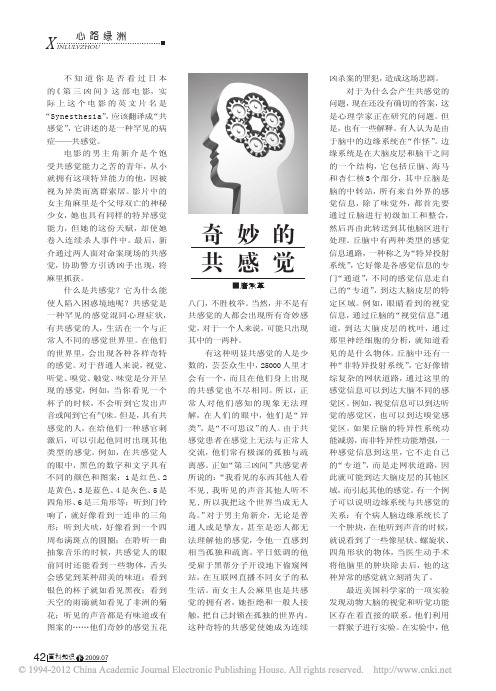
心路绿洲INLULVZHOUX不知道你是否看过日本的《第三凶间》这部电影,实际上这个电影的英文片名是“Synesthesia”,应该翻译成“共感觉”,它讲述的是一种罕见的病症——共感觉。
电影的男主角新介是个饱受共感觉能力之苦的青年,从小就拥有这项特异能力的他,因被视为异类而离群索居。
影片中的女主角麻里是个父母双亡的神秘少女,她也具有同样的特异感觉能力,但她的这份天赋,却使她卷入连续杀人事件中。
最后,新介通过两人面对命案现场的共感觉,协助警方引诱凶手出现,将麻里抓获。
什么是共感觉?它为什么能使人陷入困惑境地呢?共感觉是一种罕见的感觉混同心理症状,有共感觉的人,生活在一个与正常人不同的感觉世界里。
在他们的世界里,会出现各种各样奇特的感觉。
对于普通人来说,视觉、听觉、嗅觉、触觉、味觉是分开呈现的感觉,例如,当你看见一个杯子的时候,不会听到它发出声音或闻到它有气味。
但是,具有共感觉的人,在给他们一种感官刺激后,可以引起他同时出现其他类型的感觉。
例如,在共感觉人的眼中,黑色的数字和文字具有不同的颜色和图案:1是红色、2是黄色、3是蓝色、4是灰色、5是四角形、6是三角形等;听到门铃响了,就好像看到一连串的三角形;听到犬吠,好像看到一个四周布满斑点的圆圈;在聆听一曲抽象音乐的时候,共感觉人的眼前同时还能看到一些物体,舌头会感觉到某种甜美的味道;看到银色的杯子就如看见黑夜;看到天空的雨滴就如看见了非洲的菊花;听见的声音都是有味道或有图案的……他们奇妙的感觉五花八门,不胜枚举。
当然,并不是有共感觉的人都会出现所有奇妙感觉,对于一个人来说,可能只出现其中的一两种。
有这种明显共感觉的人是少数的,芸芸众生中,25000人里才会有一个,而且在他们身上出现的共感觉也不尽相同。
所以,正常人对他们感知的现象无法理解,在人们的眼中,他们是“异类”,是“不可思议”的人。
由于共感觉患者在感觉上无法与正常人交流,他们常有极深的孤独与疏离感。
英语修辞手法及例句

英修辞手法及例句一、明〔simile〕是以两种具有相同特征的事物和象行比,说明本体和体之的相似关系,两者都在比中出。
常用比like,as,asif,asthough等,例如:1、Thiselephantislikeasnakeasanybodycansee.象和任何人到的一像一条蛇。
2、Helookedasifhehadjuststeppedoutofmybookoffairytalesandhadpassedmelikeaspirit.他看上去好似从我的童故事中走出来,像幽灵一从我身旁走去。
3、Ithaslongleavesthatswayinthewindlikeslimfingersreachingtotouchsomething.它那的叶子在中,好似伸出的手指去触摸什么西似的。
二、〔metaphor〕种比不通比行,而是直接将用事物当作乙事物来描写,甲乙两事物之的系和相似之是暗含的。
1、Thediamonddepartmentwastheheartandcenterofthestore.石部是商店的心和核心。
isapig.他直是猪。
〔比:他是一个像猪一般的人,指,吃的人。
〕isawomanwithastonyheart.她是一个石心的女人。
〔比:个女人冷酷无情。
〕TwainisamirrorofAmerica.克?吐温是美国的一面子。
〔用子比美国的,很切。
〕三、提〔synecdoche〕提是不直接某一事物的名称,而是借事物的本身所呈的各种的象来表事物的一种修辞手段。
主要借助于密切的关系与想,而提是借助于局部相似。
提大致四种情况:a.局部和全体互代;b.以材料代替事物;c.抽象和具体互代;d.以个体代替整个。
例如:1.Outside,(thereis)aseaoffaces.外面街上,是人的海洋。
〔以人体的局部代全体,即以faces表示people〕2.Haveyouanycoppers?你有〔以材料代事物,即以copper指coinmoney〕sharethesameroof.他住在一起。
修辞手法——精选推荐
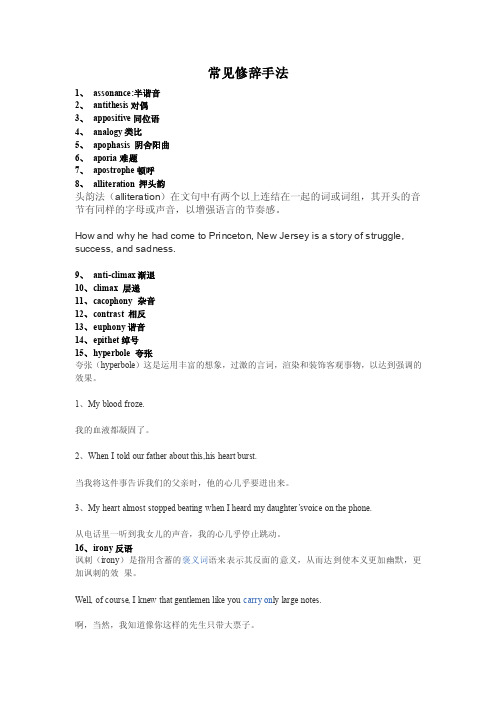
常见修辞手法1、assonance:半谐音2、antithesis对偶3、appositive同位语4、analogy类比5、apophasis 阴舍阳曲6、aporia难题7、apostrophe顿呼8、alliteration 押头韵头韵法(alliteration)在文句中有两个以上连结在一起的词或词组,其开头的音节有同样的字母或声音,以增强语言的节奏感。
How and why he had come to Princeton, New Jersey is a story of struggle, success, and sadness.9、anti-climax渐退10、c limax 层递11、c acophony 杂音12、c ontrast 相反13、e uphony谐音14、e pithet绰号15、h yperbole 夸张夸张(hyperbole)这是运用丰富的想象,过激的言词,渲染和装饰客观事物,以达到强调的效果。
1、My blood froze.我的血液都凝固了。
2、When I told our father about this,his heart burst.当我将这件事告诉我们的父亲时,他的心几乎要迸出来。
3、My heart almost stopped beating when I heard my daughter’svoice on the phone.从电话里一听到我女儿的声音,我的心几乎停止跳动。
16、i rony反语讽刺(irony)是指用含蓄的褒义词语来表示其反面的意义,从而达到使本义更加幽默,更加讽刺的效果。
Well, of course, I knew that gentlemen like you carry on ly large notes.啊,当然,我知道像你这样的先生只带大票子。
店员这句话意在讽刺这位穿破衣的顾客:像你这样的人怎么会有大票子呢?名为“gentlemen”实则“beg gar”而已。
synesthesia修辞例句
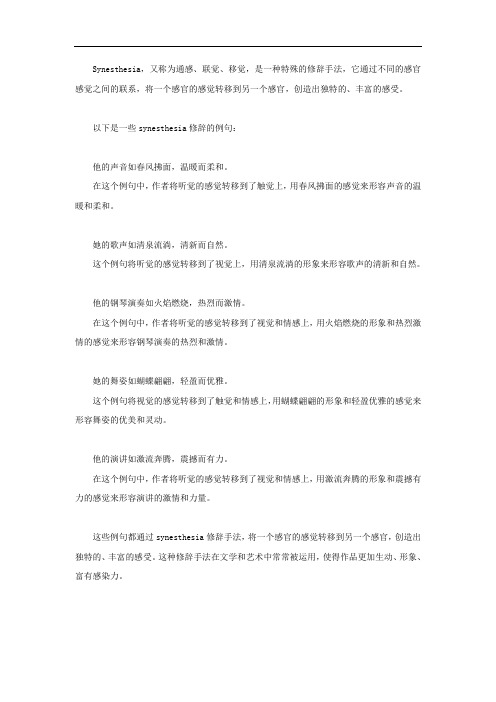
Synesthesia,又称为通感、联觉、移觉,是一种特殊的修辞手法,它通过不同的感官感觉之间的联系,将一个感官的感觉转移到另一个感官,创造出独特的、丰富的感受。
以下是一些synesthesia修辞的例句:
他的声音如春风拂面,温暖而柔和。
在这个例句中,作者将听觉的感觉转移到了触觉上,用春风拂面的感觉来形容声音的温暖和柔和。
她的歌声如清泉流淌,清新而自然。
这个例句将听觉的感觉转移到了视觉上,用清泉流淌的形象来形容歌声的清新和自然。
他的钢琴演奏如火焰燃烧,热烈而激情。
在这个例句中,作者将听觉的感觉转移到了视觉和情感上,用火焰燃烧的形象和热烈激情的感觉来形容钢琴演奏的热烈和激情。
她的舞姿如蝴蝶翩翩,轻盈而优雅。
这个例句将视觉的感觉转移到了触觉和情感上,用蝴蝶翩翩的形象和轻盈优雅的感觉来形容舞姿的优美和灵动。
他的演讲如激流奔腾,震撼而有力。
在这个例句中,作者将听觉的感觉转移到了视觉和情感上,用激流奔腾的形象和震撼有力的感觉来形容演讲的激情和力量。
这些例句都通过synesthesia修辞手法,将一个感官的感觉转移到另一个感官,创造出独特的、丰富的感受。
这种修辞手法在文学和艺术中常常被运用,使得作品更加生动、形象、富有感染力。
音乐与产品的结合——感性与理性的交互
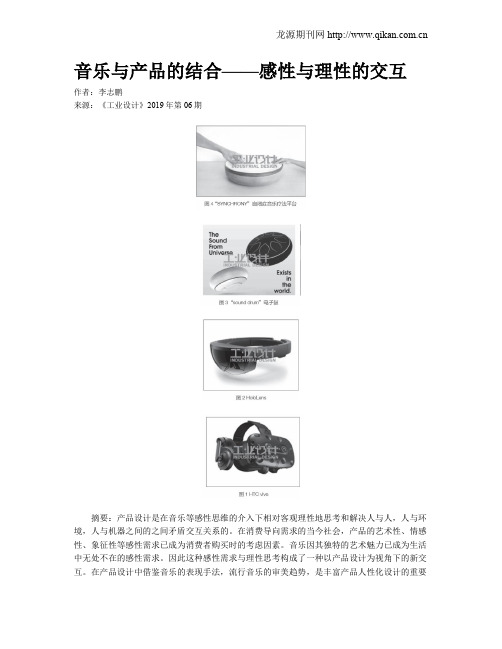
音乐与产品的结合——感性与理性的交互作者:李志鹏来源:《工业设计》2019年第06期摘要:产品设计是在音乐等感性思维的介入下相对客观理性地思考和解决人与人,人与环境,人与机器之间的之间矛盾交互关系的。
在消费导向需求的当今社会,产品的艺术性、情感性、象征性等感性需求已成为消费者购买时的考虑因素。
音乐因其独特的艺术魅力已成为生活中无处不在的感性需求。
因此这种感性需求与理性思考构成了一种以产品设计为视角下的新交互。
在产品设计中借鉴音乐的表现手法,流行音乐的审美趋势,是丰富产品人性化设计的重要层面,同时为智能化音乐产品设计研究带来新的设计思路。
文章从音乐与产品的关联交互,音乐和产品交互设计的案例这两方面来论述感性与理性的交互。
关键词:感性化;消费需求;交互中国分类号:TB472 文献标识码:A文章编码:1672-7053(2019)06-0070-021 音乐与产品的关联交互从广义上讲,音乐是一种艺术的、愉悦的、谨慎的语言或者说是一种其他安排的声音,是一系列声乐,沉默和时间的组织。
在音乐学上,普遍认为“音乐是一种利用有组织的音乐创作艺术形象,表达人们内心的思想和情感,反映社会现实生活的艺术”[1]。
消费者的消费需求已转变为“感性消费”。
产品的研发设计也以满足用户个性,操作情感化、多样化的需求为主导。
逐渐地,产品设计朝着以消费者体验的感性目标发展的同时也考虑到理性的现代主义设计原则——功能主义,于是产品设计进入了一个感性的后现代主义时代。
在感性的融交互下,音乐相关的智能产品(如Al语音助手、MP3、GD播放器、智能手机等)如雨后春笋般生长,象征着个性,代表着最为时尚的感性,在满足消费者情感需求的同时,甚至在一定程度上引领了设计的潮流,影响着整个数码产品设计的审美和发展方向[2]。
1.1 共鸣交互汉斯力克曾说,“其他艺术是说服我们,音乐则是突然袭击我们”[3]。
音乐其实是情感化的艺术表达,今天的产品设计也趋向于抒发情感。
感官疾病——Synesthesia (联觉)
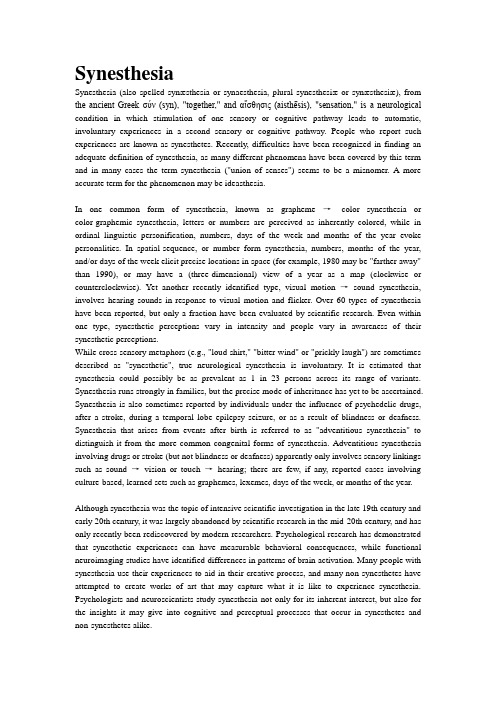
SynesthesiaSynesthesia (also spelled synæsthesia or synaesthesia, plural synesthesiæ or synæsthesiæ), from the ancient Greek σύν (syn), "together," and αἴσθησις (aisthēsis), "sensation," is a neurological condition in which stimulation of one sensory or cognitive pathway leads to automatic, involuntary experiences in a second sensory or cognitive pathway. People who report such experiences are known as synesthetes. Recently, difficulties have been recognized in finding an adequate definition of synesthesia, as many different phenomena have been covered by this term and in many cases the term synesthesia ("union of senses") seems to be a misnomer. A more accurate term for the phenomenon may be ideasthesia.In one common form of synesthesia, known as grapheme →color synesthesia or color-graphemic synesthesia, letters or numbers are perceived as inherently colored, while in ordinal linguistic personification, numbers, days of the week and months of the year evoke personalities. In spatial-sequence, or number form synesthesia, numbers, months of the year, and/or days of the week elicit precise locations in space (for example, 1980 may be "farther away" than 1990), or may have a (three-dimensional) view of a year as a map (clockwise or counterclockwise). Yet another recently identified type, visual motion →sound synesthesia, involves hearing sounds in response to visual motion and flicker. Over 60 types of synesthesia have been reported, but only a fraction have been evaluated by scientific research. Even within one type, synesthetic perceptions vary in intensity and people vary in awareness of their synesthetic perceptions.While cross-sensory metaphors (e.g., "loud shirt," "bitter wind" or "prickly laugh") are sometimes described as "synesthetic", true neurological synesthesia is involuntary. It is estimated that synesthesia could possibly be as prevalent as 1 in 23 persons across its range of variants. Synesthesia runs strongly in families, but the precise mode of inheritance has yet to be ascertained. Synesthesia is also sometimes reported by individuals under the influence of psychedelic drugs, after a stroke, during a temporal lobe epilepsy seizure, or as a result of blindness or deafness. Synesthesia that arises from events after birth is referred to as "adventitious synesthesia" to distinguish it from the more common congenital forms of synesthesia. Adventitious synesthesia involving drugs or stroke (but not blindness or deafness) apparently only involves sensory linkings such as sound →vision or touch →hearing; there are few, if any, reported cases involving culture-based, learned sets such as graphemes, lexemes, days of the week, or months of the year.Although synesthesia was the topic of intensive scientific investigation in the late 19th century and early 20th century, it was largely abandoned by scientific research in the mid-20th century, and has only recently been rediscovered by modern researchers. Psychological research has demonstrated that synesthetic experiences can have measurable behavioral consequences, while functional neuroimaging studies have identified differences in patterns of brain activation. Many people with synesthesia use their experiences to aid in their creative process, and many non-synesthetes have attempted to create works of art that may capture what it is like to experience synesthesia. Psychologists and neuroscientists study synesthesia not only for its inherent interest, but also for the insights it may give into cognitive and perceptual processes that occur in synesthetes and non-synesthetes alike.Definitional criteriaAlthough sometimes spoken of as a "neurological condition," synesthesia is not listed in either the DSM-IV or the ICD classifications, since it most often does not interfere with normal daily functioning. Indeed, most synesthetes report that their experiences are neutral, or even pleasant. Rather, like color blindness or perfect pitch, synesthesia is a difference in perceptual experience and the term "neurological" simply reflects the brain basis of this perceptual difference (see below for associated cognitive traits).It was once assumed that synesthetic experiences were entirely different from synesthete to synesthete, but recent research has shown that there are underlying similarities that can be observed when large numbers of synesthetes are examined together. For example, sound-color synesthetes, as a group, tend to see lighter colors for higher sounds and grapheme-color synesthetes, as a group, share significant preferences for the color of each letter (e.g., A tends to be red; O tends to be white or black; S tends to be yellow etc.,). Nonetheless, there are a great number of types of synesthesia, and within each type, individuals can report differing triggers for their sensations, and differing intensities of experiences. This variety means that defining synesthesia in an individual is difficult, and the majority of synesthetes are completely unaware that their experiences have a name. However, despite the differences between individuals, there are a few common elements that define a true synesthetic experience.Neurologist Richard Cytowic identifies the following diagnostic criteria of synesthesia in his first edition book. However, the criteria are different in the second book1.Synesthesia is involuntary and automatic.2.Synesthetic perceptions are spatially extended, meaning they often have a sense of "location." For example, synesthetes speak of "looking at" or "going to" a particular place to attend to the experience.3.Synesthetic percepts are consistent and generic (i.e., simple rather than pictorial).4.Synesthesia is highly memorable.5.Synesthesia is laden with affect.Cytowic's early cases included individuals whose synesthesia was frankly projected outside the body (e.g., on a "screen" in front of one's face). Later research showed that such stark externalization occurs in a minority of synesthetes. Refining this concept, Cytowic and Eagleman differentiate between "localizers" and "non-localizers" to distinguish those synesthetes whose perceptions have a definite sense of spatial quality.ExperiencesSynesthetes often report that they were unaware their experiences were unusual until they realized other people did not have them, while others report feeling as if they had been keeping a secret their entire lives, as has been documented in interviews with synesthetes on how they discovered synesthesia in their childhood. The automatic and ineffable nature of a synesthetic experience means that the pairing may not seem out of the ordinary. This involuntary and consistent nature helps define synesthesia as a real experience. Most synesthetes report that their experiences arepleasant or neutral, although, in rare cases, synesthetes report that their experiences can lead to a degree of sensory overload.Though often stereotyped in the popular media as a medical condition or neurological aberration, many synesthetes themselves do not perceive their synesthetic experiences as a handicap. To the contrary, most report it as a gift—an additional "hidden" sense—something they would not want to miss. Most synesthetes become aware of their "hidden" and different way of perceiving in their childhood. Some have learned how to apply this gift in daily life and work. Synesthetes have used their gift in memorizing names and telephone numbers, mental arithmetic, but also in more complex creative activities like producing visual art, music, and theater.Despite the commonalities which permit definition of the broad phenomenon of synesthesia, individual experiences vary in numerous ways. This variability was first noticed early on in synesthesia research but has only recently come to be re-appreciated by modern researchers. Some grapheme →color synesthetes report that the colors seem to be "projected" out into the world (called "projectors"), while most report that the colors are experienced in their "mind's eye" (called "associators"). It is estimated that approximately one or two per hundred grapheme-color synesthetes are projectors; the rest are associators.Additionally, some grapheme →color synesthetes report that they experience their colors strongly, and show perceptual enhancement on the perceptual tasks described below, while others (perhaps the majority) do not, perhaps due to differences in the stage at which colors are evoked. Some synesthetes report that vowels are more strongly colored, while for others consonants are more strongly colored. In summary, self reports, autobiographical notes by synesthetes and interviews show a large variety in types of synesthesia, intensity of the synesthetic perceptions, awareness of the difference in perceiving the physical world from other people, the way they creatively use their synesthesia in work and daily life. The descriptions below give some examples of synesthetes' experiences, which have been experimentally tested, but do not exhaust their rich variety.Various formsSynesthesia can occur between nearly any two senses or perceptual modes, and at least one synesthete, Solomon Shereshevsky, experienced synesthesia that linked all five senses. Given the large number of forms of synesthesia, researchers have adopted a convention of indicating the type of synesthesia by using the following notation x →y, where x is the "inducer" or trigger experience, and y is the "concurrent" or additional experience. For example, perceiving letters and numbers (collectively called graphemes) as colored would be indicated as grapheme →color synesthesia. Similarly, when synesthetes see colors and movement as a result of hearing musical tones, it would be indicated as tone →(color, movement) synesthesia.While nearly every logically possible combination of experiences can occur, several types aremore common than others.Grapheme →color synesthesiaIn one of the most common forms of synesthesia, grapheme →color synesthesia, individual letters of the alphabet and numbers (collectively referred to as graphemes), are "shaded" or "tinged" with a color. While different individuals usually do not report the same colors for all letters and numbers, studies with large numbers of synesthetes find some commonalities across letters (e.g., A is likely to be red).As a child, Pat Duffy told her father, "I realized that to make an R all I had to do was first write a P and draw a line down from its loop. And I was so surprised that I could turn a yellow letter into an orange letter just by adding a line." Another grapheme synesthete says, "When I read, about five words around the exact one I'm reading are in color. It's also the only way I can spell. In elementary school I remember knowing how to spell the word 'priority' [with an "i" rather than an "e"] because ... an 'e' was out of place in that word because 'e's were yellow and didn't fit."Spatial Sequence SynesthesiaAccording to Richard Cytowic, sound →color synesthesia, or chromesthesia is "something like fireworks": voice, music, and assorted environmental sounds such as clattering dishes or dog barks trigger color and firework shapes that arise, move around, and then fade when the sound ends. For some, the stimulus type is limited (e.g., music only, or even just a specific musical key); for others, a wide variety of sounds triggers synesthesia.Sound often changes the perceived hue, brightness, scintillation, and directional movement. Some individuals see music on a "screen" in front of their faces. Deni Simon, for whom music produces waving lines "like oscilloscope configurations – lines moving in color, often metallic with height, width and, most importantly, depth. My favorite music has lines that extend horizontally beyond the 'screen' area.”Individuals rarely agree on what color a given sound is (composers Liszt and Rimsky-Korsakov famously disagreed on the colors of music keys)[citation needed]; however, synesthetes show the same trends as non-synesthetes do. For example, both groups say that loud tones are brighter than soft tones, and that lower tones are darker than higher tones. Synaesthetes nevertheless choose more precise colours than non-synesthetes and are more consistent in their choice of colours given a set of sounds of varying pitch, timbre and composition.Number form synesthesiaA number form is a mental map of numbers, which automatically and involuntarily appears whenever someone who experiences number-forms thinks of numbers. Number forms were first documented and named by Francis Galton in "The Visions of Sane Persons". Later research has identified them as a type of synesthesia. In particular, it has been suggested that number-forms are a result of "cross-activation" between regions of the parietal lobe that are involved in numerical cognition and spatial cognition. In addition to its interest as a form of synesthesia, researchers in numerical cognition have begun to explore this form of synesthesia for the insights that it may provide into the neural mechanisms of numerical-spatial associations present unconsciously in everyone.PersonificationOrdinal-linguistic personification (OLP, or personification for short) is a form of synesthesia in which ordered sequences, such as ordinal numbers, days, months and letters are associated with personalities. Although this form of synesthesia was documented as early as the 1890s modern research has, until recently, paid little attention to this form.For example, one synesthete says, "T’s a re generally crabbed, ungenerous creatures. U is a soulless sort of thing. 4 is honest, but… 3 I cannot trust… 9 is dark, a gentleman, tall and graceful, but politic under his suavity." Likewise, Cytowic's subject MT says, "I [is] a bit of a worrier at times, although easy-going; J [is] male; appearing jocular, but with strength of character; K [is] female; quiet, responsible...."For some people in addition to numbers and other ordinal sequences, objects are sometimes imbued with a sense of personality. Recent research has begun to show that alphanumeric personification co-varies with other forms of synesthesia, and is consistent and automatic, as required to be considered a form of synesthesia.Lexical →gustatory synesthesiaIn the rare lexical →gustatory synesthesia, individual words and the phonemes of spoken language evoke taste sensations in the mouth. According to James Wannerton, "Whenever I hear, read, or articulate (inner speech) words or word sounds, I experience an immediate and involuntary taste sensation on my tongue. These very specific taste associations never change and have remained the same for as long as I can remember."Jamie Ward and Julia Simner have extensively studied this form of synesthesia, and have found that the synesthetic associations are constrained by early food experiences. For example, James Wannerton has no synesthetic experiences of coffee or curry, even though he consumes them regularly as an adult. Conversely, he tastes certain breakfast cereals and candies that are no longer sold.Additionally, these early food experiences are often paired with tastes based on the phonemes in the name of the word (e.g., /I/, /n/ and /s/ trigger James Wannerton’s taste of mince) alth ough others have less obvious roots (e.g., /f/ triggers sherbet). To show that phonemes, rather than graphemes are the critical triggers of tastes, Ward and Simner showed that, for James Wannerton, the taste of egg is associated to the phoneme /k/, whether spelled with a "c" (e.g., accept), "k" (e.g., York), "ck" (e.g., chuck) or "x" (e.g., fax). Another source of tastes comes from semantic influences, so that food names tend to taste of the food they match, and the word "blue" tastes "inky."Auditory-tactile synesthesiaAuditory-tactile synesthesia may originate from birth or be acquired sometime in life. It is one of the rarest forms of synesthesia.Mirror touch synesthesia[edit]In this rare form of synesthesia, seeing someone else being touched, leads to feeling the touch as well. This means that people can literally feel the pain of others when they see them get hurt. Such a process of simulation is hypothized to be important for understanding and empathising with others.Research historyThe interest in colored hearing dates back to Greek antiquity, when philosophers asked if the color (chroia, what we now call timbre) of music was a quantifiable quality. Isaac Newton proposed that musical tones and color tones shared common frequencies, as did Goethe in his book, "Theory of Color." Despite this idea being false, there is a long history of building color organs such as the clavier à lumières on which to perform colored music in concert halls.The first medical description of colored hearing is in a German 1812 thesis. The father of psychophysics, Gustav Fechner reported the first empirical survey of colored letter photisms among 73 synesthetes in 1871, followed in the 1880s by Francis Galton. Research into synesthesia proceeded briskly in several countries, but due to the difficulties in measuring subjective experiences and the rise of behaviorism, which made the study of any subjective experience taboo, synesthesia faded into scientific oblivion between 1930 and 1980.As the 1980s cognitive revolution began to make inquiry into internal subjective states respectable again, scientists once again looked to synesthesia. Led in the United States by Larry Marks and Richard Cytowic, and later in England by Simon Baron-Cohen and Jeffrey Gray, research explored the reality, consistency, and frequency of synesthetic experiences. In the late 1990s, the focus settled on grapheme →color synesthesia, one of the most common and easily studied types. Synesthesia is now the topic of scientific books and papers, Ph.D. theses, documentary films, and even novels.Since the rise of the Internet in the 1990, synesthetes began contacting one another and creating Web sites devoted to the condition. These early grew into international organizations such as the American Synesthesia Association, the UK Synaesthesia Association, the Belgian Synaesthesia Association, the German Synesthesia Association and the Netherlands Synesthesia Web Community.Prevalence and genetic basisEarly estimates of prevalence varied widely (from 1 in 20 to 1 in 20,000). These studies all had the methodological shortcoming of relying on self-selection, meaning individuals reporting their experience to investigators. Random population studies later determined that 1 in 23 individuals have some kind of synesthesia, while 1 in 90 have colored graphemes. Colored days of the week and colored graphemes are the most common types.Many studies noted that synesthesia runs in families, consistent with a genetic origin for the condition. Francis Galton's 1880 report noted a familial component. Studies from the 1990s that noted a much higher prevalence in women than men (up to 6:1) most likely suffered from a sampling bias due to the fact that women are more likely to self-disclose than men. More recent random samples find an equal sex ratio of 1.1:1.At first, the observed patterns of inheritance were consistent with an X-linked mode of inheritance because there had been no verified reports of father-to-son transmission, whereas father-to-daughter, mother-to-son and mother-to-daughter transmission were readily observed. However, the first genome-wide association study failed to find X-linkage, and furthermore verified two cases of father-to-son transmission.Suggestive of incomplete gene penetrance is the situation of identical twins in which only one member of the pair is synesthetic, and the observation that synesthesia can skip generations withina family. It is furthermore common for family members to experience different types of synesthesia, suggesting that the gene(s) involved do not lead to invariably specific types of synesthesia. Developmental factors such as gene expression and environment must also play a role in determining which types of synesthesia an individual has (for example, children must interact with culturally learned artifacts such as alphabets and food names).Objective verificationThe simplest approach is test-retest reliability over long periods of time, where synesthetes consistently score much higher—around 90% after years, compared to 30–40% after just a month in non-synesthetes even when they are warned they will be retested—using stimuli of color names, color chips, or a computer-screen color picker providing 16.7 million choices.Modified versions of the Stroop effect are popular. In the standard paradigm, it is harder to name the ink color of the word "red," for example, when it is printed in blue ink than when the ink is red. Similarly, if a grapheme →color synesthete is shown the digit 4 (which he sees as red, say) in blue ink, he is slower to name the ink color than when it is printed in red. He sees the blue ink, but the same sort of conflict responsible for the standard Stroop effect occurs between the ink color and the automatic synesthetic color of the grapheme. The conflict is strongest when the ink color is the opponent color to the synesthetic one (e.g., red vs. green), indicating that synesthetic color perception uses the same mechanism as the perception of real colors.Cross-sensory Stroop tests are possible: for example, a music →color synesthete must name a red swatch while listening to a sound that produces a blue sensation, or a musical key →taste synesthete must identify a bitter taste while hearing a musical interval that tastes sweet . Likewise, Stroop tests work even in those for whom merely thinking about a numeral elicits color. Take a person who sees 7 as yellow and 9 as blue, and make the task one of having to say a math solution out loud followed by naming a color square. In the illustration, having to answer "7" and then "yellow" is congruent with the subject’s synesthesia, which unconsciously primes him to respond faster than controls. The automatic blueness of 9, however, interferes with naming the green square, slowing him down compared to controls.Synesthetic colors can also improve performance for some synesthetes. Inspired by tests for color blindness, Ramachandran and Hubbard presented synesthetes and non-synesthetes with a matrix of 5s in which embedded 2s formed a hidden pattern such as a square, diamond, rectangle or triangle. For someone who sees 2s as red and 5s as green, for example, synesthetic colors help zero in on the embedded figure. Subsequent careful studies have found substantial variability among synesthetes in their ability to do this. It certainly does not happen instantaneously; while synesthesia is evoked very early in perceptual processing, it does not occur prior to attention.Possible neural basisDedicated regions of the brain are specialized for given functions. Increased cross-talk between regions specialized for different functions may account for the many types of synesthesia. For example, the additive experience of seeing color when looking at graphemes might be due tocross-activation of the grapheme-recognition area and the color area called V4 (see figure). One line of thinking is that a failure to prune synapses that are normally formed in great excess during the first few years of life may cause such cross-activation.An alternate possibility is disinhibited feedback, or a reduction in the amount of inhibition along normally existing feedback pathways. Normally, excitation and inhibition are balanced. However, if normal feedback were not inhibited as usual, then signals feeding back from late stages of multi-sensory processing might influence earlier stages such that tones could activate vision. Cytowic & Eagleman find support for the disinhibition idea in the so-called acquired forms[3] of synesthesia that occur in non-synesthetes under certain conditions: Temporal lobe epilepsy, head trauma, stroke, and brain tumors. They also note that it can likewise occur during stages of meditation, deep concentration, sensory deprivation, or with use of psychedelics such as LSD or mescaline, or even, in some cases, marijuana. However, synesthetes report that common stimulants, like caffeine and cigarettes do not affect the strength of their synesthesia, nor do alcoholic beverages.Functional neuroimaging studies using PET and fMRI demonstrate significant differences between the brains of synesthetes and non-synesthetes. fMRI shows V4 activation in both word →color and grapheme →color synesthetes. Diffusion tensor imaging allows visualization of white matter fiber pathways in the intact brain. This method demonstrates increased connectivity in fusiform gyrus, intraparietal sulcus and frontal cortex in grapheme-color synesthetes. The degree of white matter connectivity in the fusiform gyrus correlates with the intensity of the synesthetic experience.The role of meaningEvidence has shown that concurrents in synesthesia may be operating at the level of the meaning of the stimulus (i.e. semantic representations), not at the level of the sensory inputs. For example, if presented with letter A, a synesthete would associated concurrent experiences only once the letter has been recognized and the meaning of the stimulus has been extracted. Hence, the basics for understanding synesthesia may be in the semantic structures that, uniquely for synesthetes, associate sensory-like experiences. It has been proposed that a more accurate definition of the phenomenon is within the context of ideasthesia.Associated cognitive traitsLittle is known about what, if any, cognitive traits might be associated with synesthesia. As early as 1980, Richard Cytowic first noted mild difficulties in left-right confusion, arithmetic, and sense of direction. These observations await large-scale confirmation. What has been confirmed is elevated, sometimes photographic, memory. It was reading Alexander Luria's 1968 book The Mind of a Mnemonist that alerted Cytowic to the link between synesthesia and enhanced memory: Luria's subject had a 5-fold synesthesia that gave him extra hooks on which to hang and remember numerous facts.Autism and epilepsy occur with synesthesia more often than chance predicts. Daniel Tammet, the savant who set a European record for reciting the digits of pi, has all three conditions indicating that they might share an underlyinggenetic cause. Synesthesia has so far been linked to a region on chromosome 2 that is associated with autism and epilepsy.Synesthetes are likely to participate in creative activities. Individual development of perceptual and cognitive skills, and one's cultural environment likely determine the variety in awareness and practical use of synesthetic skills. These are major topics of ongoing research.Links with other areas of studyResearchers study synesthesia raising questions such as how the brain combines information from different sensory modalities, referred to as crossmodal perception and multisensory integration.An example of this is the bouba/kiki effect. In an experiment first designed by Wolfgang Köhler, people are asked to choose which of two shapes is named bouba and which kiki. 95% to 98% of people choose kiki for the angular shape and bouba for the rounded one. Individuals on the island of Tenerife showed a similar preference between shapes called takete and maluma. Even 2.5 year-old children (too young to read) show this effect.Ramachandran and Hubbard suggest the kiki/bouba effect has implications for the evolution of language, because the naming of objects is not completely arbitrary. The rounded shape may intuitively be named bouba because the mouth makes a more rounded shape to produce that sound, while a more taut, angular mouth shape is needed to articulate kiki. The sound of K is also harder and more forceful than that of B. Such "synesthesia-like mappings" suggest that this effect might be the neurological basis for sound symbolism, in which sounds are non-arbitrarily mapped to objects and actions in the world.Given synesthetes' extraordinary conscious experiences, researchers hope that their study will provide better understanding of consciousness and its neural correlates, meaning what the brain mechanisms that make us conscious might be. In particular, synesthesia might be relevant to the philosophical problem of qualia, given that synesthetes experience extra qualia (e.g., a colored sound).Artistic investigationsThe word "synesthesia" has been used for 300 years to describe very different things, from poetry and metaphor to deliberately contrived mixed-media applications such as son et lumière shows or odorama. It is crucial[why?] to separate artists using synesthesia as an intellectual idea—pseudo-synesthetes such as Georgia O'Keeffe who used such titles as "Music-Pink and Blue"—from those who had the genuine perceptual variety, such as Wassily Kandinsky or Olivier Messiaen.Synesthetic art historically refers to multi-sensory experiments in the genres of visual music, music visualization, audiovisual art, abstract film, and intermedia. Distinct from neuroscience, the concept of synesthesia in the arts is regarded as the simultaneous perception of multiple stimuli in one gestalt experience. Only recently can science verify and study synesthesia in artists; for deceased artists, one must interpret (auto)biographical information.Synesthetic art can refer to either art created by synesthetes or art that attempts to convey the。
- 1、下载文档前请自行甄别文档内容的完整性,平台不提供额外的编辑、内容补充、找答案等附加服务。
- 2、"仅部分预览"的文档,不可在线预览部分如存在完整性等问题,可反馈申请退款(可完整预览的文档不适用该条件!)。
- 3、如文档侵犯您的权益,请联系客服反馈,我们会尽快为您处理(人工客服工作时间:9:00-18:30)。
• 视觉的次感元有:视觉的次感元有:光亮 度、大小(形状)、颜色、距离、清晰度、 位置、对比、动或静画、全画面或有框架、 速度、立体或平面、光的角度等。 • 听觉的次感元有:来源方向、距离、速度、 音量、声调、清晰度、位置、内外、拍子、 对比、持续或间断等
• sensory integration:感觉统合。感觉统合是指大 脑和身体相互协调的学习过程。指机体在环境内 有效利用自己的感官,以不同的感觉通路 (视觉、 听觉、味觉、嗅觉、触觉、前庭觉和本体觉等) 从环境中获得信息输入大脑,大脑再对其信息进 行加工处理,(包括:介释、比较、增强、抑制、 联系、统一),并作出适应性反应的能力,简称 “感统”。简单地讲,感觉统合是一种大脑和身 体相互协调的学习过程,没有感觉统合,大脑和 身体都不能发展。
(1)The rooms on the first floor are decrated with cold color. (2)I caressed the darkness with cool fingers. • 3.Sense of touch mixed with sense of hearing (1)That is a tart reply. (2)"listen, where is the sharp cry?"
Examples Analysis
• “微风过处,送来缕缕清香,仿佛远处高楼上 渺茫的歌声似的” “缕缕清香”诉诸嗅觉,“渺茫歌声”诉诸听 觉,作者将二者沟通起来,用若有若无断断续 续轻而飘的歌声来形容随风飘散缕缕不绝 淡而雅的荷香,勾画出一个令人陶醉的优美 意境,表达了作者倾心品味荷香,暂时排遣郁 闷的淡淡愉悦之情。(此句有争议,一般被 视为比喻和通感的兼用。)
• “红杏枝头春意闹” 用‘闹’字,是想把事物的无声的姿态描摹 成好象有声音,表示在视觉里仿佛获得了 听觉的感受。”这就是通感。 ."The birds sat upon a tree and poured forth their lily like voice."鸟儿落在树上,倾泻出百 合花似的声音. 用视觉形容听觉,鸟落在树上,由它发出 音联想到百合花.
Each of these modalities has submodalities(次感元) . In the case of vision, for instance, includ color and, in hearing, includ pitch(音高). Our perception of light arrives to the brain via a series of photoreceptive(对光刺激敏感的) rods and cones(柱形和锥形的感光细胞) in the eye. cones Audition, on the other hand, uses information gathered by mechanoreceptive hair cell(毛细胞) in the ear that measure vibrations in air pressure.
Founctions
• 通感技巧的运用,能突破语言的局限,丰 富表情达意的审美情趣,起到增强文采的 艺术效果。尤其常见于诗歌的运用中。
Forms of Synesthesia
• 1.Sense of vision mixed with sense of hearing (1)Dean can hlep illuminate elusive music.As Stravinsky once said after watching his Movements for Piano and orcheatra:"To see balanchine's choreography is to hear music with one's eyes.The choreography emphasizes relationship of which I had hardly been aware."
(2)What a noisy scarf it is!好艳丽的一条围 巾! (3)Aril, April, laguh thy golden laughter But, the moment after, Weep thy golden tear!
• 2.Sense of vision mixed with sense of touch
The nature of the differences between five modalities is suggested by the disparate(迥然不 同的) nature of these sensory receptors(感受器). The fidings of recent neurological studies suggest the possibility that the executive areas of the human brain manifest a high degree of sensory integration(感觉统合). The human being's detection of intersensory equivalence is a widely accepted explanation for the occurence of synesthsia.
• sensation:感觉。感觉是刺激物的某种特性 进入神经系统的“通道”,它把刺激“编 码”成不同频率和强度的电磁场在神经系 统“周游”,引起相应的体态变化(包括 行为和语言)。人的感觉是非常有限的, 就种类而言,只有五种感官。
As a rhetorical term, synesthesia refers to the mixing of sensations or the stimulation of one sense (or "modality") that produces a mental impression associated with a different sense. • 通感是指感觉的混合,或某种感官上的感 觉转移到另一种感官上。
• "Taste the music of Mozart."品尝Mozart的音乐. 这里是听觉通于味觉。 "Music, when soft voices die, Vibrates in the memory--(温柔的声音已经消逝, memory-音乐仍在记忆中飘荡。) Odours, when sweet violets sticken, Live within the sense they quicken." "Voices" can be heard, but cannot be touched.Here "soft" as a feeling of touch is used to modify voices is the practice of synesthesia.
Working Mechanism
According to modern neuroscientists(神经系 统科学家),human sensory systems mediate four attributes of stimulus(刺激) that can be correlated quantitatively with a sensation: modality, intensity, duration,and location. The attributes of modality, intensity, duration,and location apply to all five sensory modalities(感觉通道): vision, hearing, touch, taste and smell.
• 4.Sense of taste mixed with sense of hearing
(1)As I tasted it, a tune came into my head. (2) That's a sour joke. 5.Sense of vision mixed with sense of touch (1)He gave me a sour look. (2)And all man kill the thing they love By all let this be heard, Some do it with a bitter look(有人用苦涩的一 瞥扼杀) Some do it with a flattering word ...
• 6.Sense of smell mixed with other sense of modalities. (1)Smell how it tastes! (2)Johson's Baby Powder: The soft smell. (3)But, in embalmed darkness, guess each sweet Wherewithin the reasonable month endows
Synesthesia
Definition
The word "synesthesia" comes from the Greek "syn-"(union), and "aisthesia"("sensation"), thus meaning something akin to "a union of the senses". As a rhetorical term, synesthesia refers to the mixing of sensations or the stimulation of one sense (or "modality") that produces a mental impression associated with a different sense.
